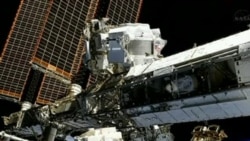Scientist say they may have evidence of dark matter, the theoretical substance that holds the cosmos together, but has never been observed directly.
During a news briefing Wednesday in Washington, scientists from the U.S. space agency, NASA, and the European particle physics laboratory near Geneva, Switzerland, said a $2 billion cosmic ray detector on the International Space Station has found what they call a "footprint" of something that could be dark matter.
But physicist Samuel Ting says the first results from the Alpha Magnetic Spectrometer, known as the AMS, could also be showing energy emitted from Pulsars, rotating, radiation-emitting stars.
"I said our evidence supports the existence of dark matter, but cannot rule out the origin comes from pulsars. But I'm confident, with enough time, because we will be on the Space Station for the lifetime of the Space Station, we should be able to solve this problem," Ting said.
The results from the detector are significant, because dark matter is thought to make up about a quarter of all the matter in the universe.
Unraveling the mystery of dark matter could help scientists better understand the composition of our universe and, more particularly, what holds galaxies together.
The seven-ton detector, was sent into space two years ago. It has a magnet ring, about a meter around at its core, and is transmitting the data to the European Organization for Nuclear Research, known as CERN, where it is being analyzed.
The new findings are based on seeing an excess of positrons - positively charged subatomic particles.
Since the highly accurate AMS magnetic detector began studying cosmic ray particles in space, it has found about 400,000 positrons where surging energies indicate they might have been created when particles of dark matter collided and destroyed each other.
The AMS will search for antimatter and dark matter for the rest of the life of the space station - until at least 2020 - transmitting data to an international team of 600 scientists in Geneva.
During a news briefing Wednesday in Washington, scientists from the U.S. space agency, NASA, and the European particle physics laboratory near Geneva, Switzerland, said a $2 billion cosmic ray detector on the International Space Station has found what they call a "footprint" of something that could be dark matter.
But physicist Samuel Ting says the first results from the Alpha Magnetic Spectrometer, known as the AMS, could also be showing energy emitted from Pulsars, rotating, radiation-emitting stars.
"I said our evidence supports the existence of dark matter, but cannot rule out the origin comes from pulsars. But I'm confident, with enough time, because we will be on the Space Station for the lifetime of the Space Station, we should be able to solve this problem," Ting said.
The results from the detector are significant, because dark matter is thought to make up about a quarter of all the matter in the universe.
Unraveling the mystery of dark matter could help scientists better understand the composition of our universe and, more particularly, what holds galaxies together.
The seven-ton detector, was sent into space two years ago. It has a magnet ring, about a meter around at its core, and is transmitting the data to the European Organization for Nuclear Research, known as CERN, where it is being analyzed.
The new findings are based on seeing an excess of positrons - positively charged subatomic particles.
Since the highly accurate AMS magnetic detector began studying cosmic ray particles in space, it has found about 400,000 positrons where surging energies indicate they might have been created when particles of dark matter collided and destroyed each other.
The AMS will search for antimatter and dark matter for the rest of the life of the space station - until at least 2020 - transmitting data to an international team of 600 scientists in Geneva.












